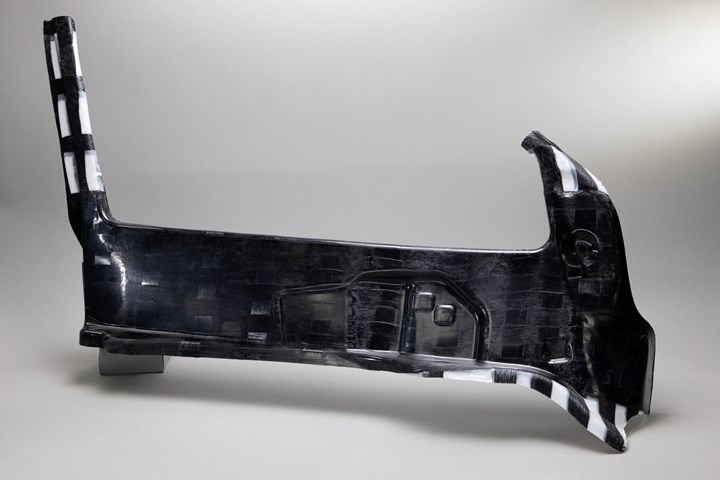Highly tunable, woven lattice reinforcements target automotive structures
CAMX 2023: Startup Weav3D will be demonstrating its two collaborative automotive demonstrator parts and present two conference papers.
Advanced manufacturing and materials startup Weav3D Inc. (Norcross, Ga., U.S.) is exhibiting applications of its Rebar for Plastics reinforcement material, including two recently unveiled automotive demonstrator parts, encompassing sustainable interior and structural body applications.
Weav3D is demonstrating the ability to replace steel, aluminum and carbon fiber composites in automotive body structures via a lattice-reinforced thermoplastic beltline stiffener door component, manufactured at the Clemson Composites Center (CCC) at Clemson University (S.C., U.S.) in partnership with Braskem (Philadelphia, Pa., U.S.), an Americas polyolefins producer and developer of biopolymers on an industrial scale. This novel design achieved 20% weight savings, 50% cost savings and a 63% reduction in trim scrap by weight, compared to a conventional carbon fiber organosheet, the company reports.
“When Weav3D and Braskem approached us to develop a prototype that showcases Weav3D’s tunable woven composite technology and the cost-effective versatility of Braskem’s polypropylene [PP] resin, we leveraged extensive stamp forming experience with thermoplastic composites from our Department of Energy Ultra-Lightweight Door program to deliver a high-rate structural automotive prototype,” says Sai Aditya Pradeep, research and development engineer at the CCC. “Our goal isn’t merely material innovation; it’s about weaving the future of sustainable automotive excellence, fusing lightweighting and sustainability with lower costs one prototype at a time.”
Further highlighting the benefits of lattice reinforcement for natural fiber materials used in automotive interiors, Weav3D will showcase an instrument panel topper pad manufactured in partnership with Antolin (Burgos, Spain), an international supplier for automotive interiors that also incorporates composite lattice-reinforced natural fiber nonwoven mats into its work. The resulting part is reported to be lighter and more sustainable than current injection molded designs made from glass-filled PP.
Lattice-reinforced natural fiber mat provides sustainable alternative to glass filled-PP for this IP topper pad.
In addition, Weav3D FEA engineer Meghana Kamble will be presenting her paper, “A Revised Finite Element Analysis Approach to Designs and Optimize Composite Lattice Reinforcements and Simulate the Mechanical Properties of Composite Lattice Reinforced Plastics,” at 10:30 a.m. on Wednesday, Nov. 1.
Christopher Oberste, Weav3D president and chief engineer, will also be presenting his paper “Rebar for Plastics — a Novel Approach to Part Optimization with Composite Lattices” at 4:30 p.m. the same day.
Related Content
-
Carbon fiber, bionic design achieve peak performance in race-ready production vehicle
Porsche worked with Action Composites to design and manufacture an innovative carbon fiber safety cage option to lightweight one of its series race vehicles, built in a one-shot compression molding process.
-
Infinite Composites: Type V tanks for space, hydrogen, automotive and more
After a decade of proving its linerless, weight-saving composite tanks with NASA and more than 30 aerospace companies, this CryoSphere pioneer is scaling for growth in commercial space and sustainable transportation on Earth.
-
Composites end markets: Automotive (2024)
Recent trends in automotive composites include new materials and developments for battery electric vehicles, hydrogen fuel cell technologies, and recycled and bio-based materials.


















